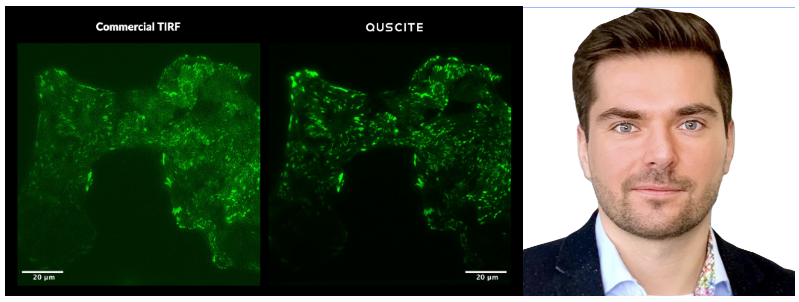News, SPPIN seminars
23/06 : Pierre Türschmann – High-throughput total internal reflection microscopy with QUSCITE
Pierre Türschmann, INTERHERENCE, Erlangen, Germany
SPPIN’s webinar 2023, 23 june at 10h in SPPIN common’s room and online – Ask link to a SPPIN member.
High-throughput total internal reflection microscopy with QUSCITE

Total internal reflection fluorescence (TIRF) microscopy has become a workhorse for many fluorescence imaging studies that rely on a high signal-to-background ratio. Research fields that particularly benefit from TIRF include single molecule biophysics and cell biology studies of processes that occur close to the plasma membrane. However, the most common technical implementation of TIRF relies on high-numerical aperture objectives, which impedes the adoption of TIRF for certain studies or users.
In my talk, I will introduce a new waveguide based TIRF module, called QUSCITE, that overcomes all well-known drawbacks of through-the-objective-TIRF technology. QUSCITE allows the researcher to not only equip any existing microscope with TIRF contrast, but it also enables a remarkably higher imaging throughput by delivering a highly homogenous evanescent field in the range of square millimeters.
Interherence is a young startup company based in Erlangen, Germany, that emerged from the local Max-Planck Institute for the Science of Light. We exploit micro and nanofabrication methods to generate highly reproducible imaging conditions, ranging from temperature to illumination.
Pierre Türschmann is the founder and CEO of Interherence.
Host: Martin Oheim
The GRAPHICAL ABSTRACT shows a direct comparison of a commercial TIRF system with QUSCITE. Our system also enables an unprecedented signal to background ratio besides the wider field of view. The image pair shows GFP-tagged vinculin expressed in a cell recorded on a commercial microscope illuminated via a standard TIRF module (left) and with QUSCITE (right). The signal-to-background ratio is x2.5 improved on the right image while all other parameters are kept constant.
Image credit: Jan Valecka, Inst. Mol. Gen. of the Czech Academy of Science, Prague
